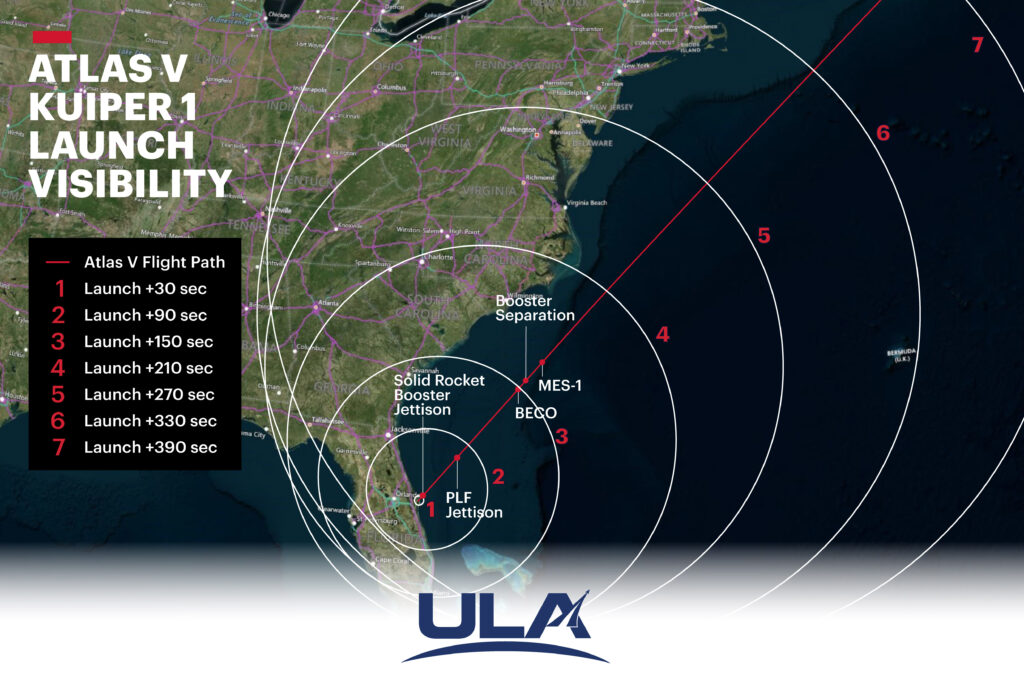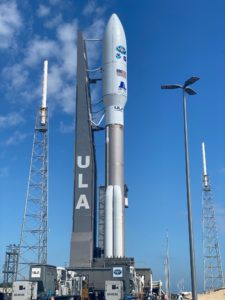
A giant rocket is scheduled to be launched along the U.S. East Coast this evening, providing residents from Florida to New England with the opportunity of seeing an Amazon mission unfold with the naked eye. United Launch Alliance (ULA) is scheduled to lift-off their Atlas 5 rocket with a batch of 27 of Amazon’s Project Kuiper internet satellites. These are the first production satellites that will make up Amazon’s satellite internet megaconstellation which will ultimately include 3,236 satellites. Amazon hopes to compete with SpaceX’s Starlink satellite-based internet service with these new rockets.
The launch is scheduled to occur at or after 7 pm this evening from Cape Canaveral Space Force Station on the central coast of Florida. After lift-off, the rocket will travel north and east along the U.S. East Coast, giving those looking off into the eastern sky the opportunity to see the rocket accelerate into space. The launch window is set from 7-9 pm, which means the rocket can launch at any time within that window.
ULA is flying its Atlas 5 in the 551 configuration, which features five solid rocket boosters and a medium-length payload fairing. ULA had initially tried to launch its rocket on April 9 but that attempt was scrubbed due to poor weather.
The forecast from the Space Force’s Space Launch Delta 45 weather squadron and Launch Weather Officer Brian Belson says weather conditions are “75% GO” for today’s launch. This means there’s a 75% chance of acceptable weather conditions. For today’s launch, meteorologists are most concerned about the Cumulus Cloud Rule, Anvil Cloud Rules, and Surface Electric Fields Rule which could force another weather-related delay.
“After fair weather this weekend, a weak boundary is expected to bring scattered showers and isolated thunderstorm activity to central Florida on Monday. The window could see coastal shower activity from onshore flow and afternoon/early evening thunderstorm activity, primarily inland and over west Florida, from interactions with the sea breeze,” the weather team says.
“Thunderstorm development may also occur over the gulf stream. Although the steering flow appears likely to keep most thunderstorm activity away from the Cape, anvil clouds could be an issue.”
If the launch moves to the backup opportunity on Tuesday for some reason, there is a 90 percent chance of meeting the weather rules.
“For the backup day, high pressure with drier air is expected to return to the Space Coast, reducing the risk of a constraint violation. Although there remains a very small risk for thunderstorm activity over the western half of the state, flight-through cumulus clouds from onshore-moving showers are the primary concern for Tuesday’s window,” the weather team says.

As the rocket heads north and east off the Florida coast, boosters will be jettisoned from the rocket, giving those along the southeast coast an interesting view. The rocket will be without boosters by the time it passes off the North Carolina coast, but even those in the Mid Atlantic and southeastern New England would be able to see the rocket with high pressure there providing for good viewing conditions.

The Atlas V is a workhorse rocket for ULA and has been used for many noteworthy launches into space. This was the rocket of choice for many of the GOES weather satellite launches, including the GOES-T rocket which was launched on March 1, 2022 from the same spaceport as today’s scheduled launch.
Kuiper Systems LLC, also known as Project Kuiper, is a subsidiary of Amazon that was established in 2019 to deploy a large satellite internet constellation to provide low-latency broadband connectivity. The name Kuiper was a company codename for the project inspired by the Kuiper belt. The Kuiper Belt is a region beyond Neptune’s orbit, filled with icy bodies, dwarf planets, and other small objects. It’s considered a remnant of the solar system’s formation and is thought to be a source of comets. The Kuiper Belt is roughly shaped like a disk or doughnut, with its inner edge starting at Neptune’s orbit and extending outward.
Amazon’s $10 billion plans to establish this internet network includes 80 launches like today’s. Establishing the internet constellation will require a series of rocket launches to get the satellites into space, but this initiative is separate from Amazon founder JeffBezos’ Blue Origin spaceflight company.